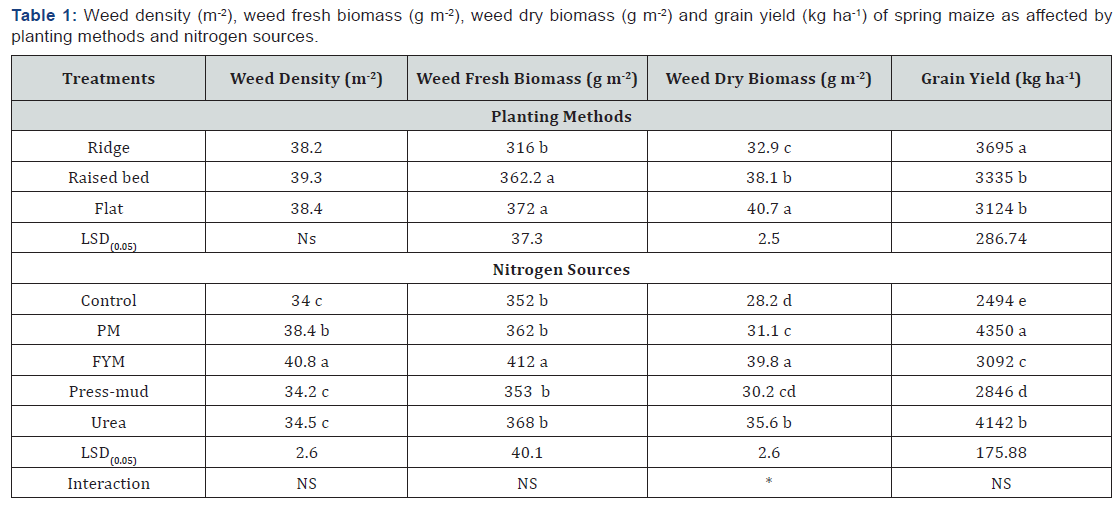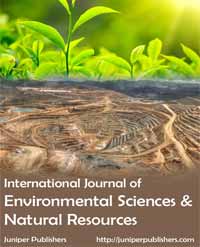Effect of Planting Methods and Nitrogen Sources on Weeds Infestation Yield of Spring Maize - Juniper Publishers
Juniper Publishers-Open Access Journal of Environmental Sciences & Natural Resources
Effect of Planting Methods and Nitrogen Sources on Weeds Infestation Yield of Spring Maize
Authored by Mansoor Javed
Abstract
A field experiment was conducted to evaluate effect of different planting methods and nitrogen sources on yield and yield components of spring maize at Agronomy Research Farm, The University of Agriculture, Peshawar during spring 2015-2016. Research work was carried out in randomized complete block design having total number of four replication. Planting methods (ridge, raised bed and flat) were assigned to main plot while different nitrogen sources (poultry manure, FYM, urea and press-mud) were allotted to sub plots. Organic manures were applied manually into soil one week before maize sowing. Analysis of data showed that all parameters of spring maize were significantly affected by different planting methods except weed density. Similarly application of FYM increases weed density, weed fresh biomass and weed dry biomass, while grain yield is recorded higher for poultry manure. Thus it is concluded that spring maize should be grown on ridges with application of poultry manure in the agro ecological condition of Peshawar.
Keywords: Spring Maize; Planting Methods; Nitrogen Sources; Yield; Weed Density.
Introduction
Maize (Zea mays L.) is an exhaustive cereal crop and can be used as food for human, feed for livestock and raw material for industries such as rafan etc [1]. Among cereal crops maize occupied third position after wheat and rice in Pakistan while it comes on second position after wheat in Khyber Pakhtunkhwa. Due to its high productive potential it is often referred as ‘king of grain crops’. According to agriculture statistics of Pakistan in 2014-2015 maize production was 4.936 thousand tonnes having total cultivated area of 1142.5 thousand hectares in Pakistan and in same year in Khyber Pakhtunkhwa it was cultivated on 463 thousand hectare area having production of 909.7 thousand tones [2]. Among the modern agro-management techniques planting method is one of the crucial factors for improving crop yield. Different planting methods are practiced in the world for maize sowing. Ridge planting can be consider as alternative to no tillage practices [3] documented that ridge method of planting significantly increased yield of maize crop in comparison with other planting methods. Nitrogen is one of the major plant nutrients and plays an active role in plant growth and development. FYM, press mud and poultry manure are organic sources of nitrogen which can be used instead of chemical fertilizers for getting higher yield of crops. Continuous application of chemical fertilizers in the soils causes toxicity, depletion of soil fertility and decreases activities of soil microorganisms. Organic manures are the best substitute of chemical fertilizers for improving soil fertility. Poultry manure contains highest percentage of N, P, K andis valuable organic manure [4]. Keeping in view the importance of planting methods and nitrogen sources for achieving higher grain yield from maize the present study was planned to study the effect of planting methods and nitrogen sources on yield and yield components of spring maize.
Material and Methods
The research trail was conducted in Agronomy Research Farm, The University of Agriculture, and Peshawar during spring 2015-16. The treatments comprised three planting methods ( ridge, raised bed and flat) and four different nitrogen sources (poultry manure, FYM, press mud and urea).The field research was carried out in Randomized Complete Block Design (RCBD) in split plot arrangements keeping planting methods in main plots and different nitrogen sources in subplots. Desired amount of 200kg N ha-1were fulfilled from all these sources. Control treatment was also included in the trail. Organic nitrogen sources were applied manually one week before maize sowing. Net plot size was 4m × 4.2 m. Data were recorded on weed density 70 days after sowing (DAS), fresh and dry weed biomass 70 DAS. Weed density was recorded at 70 DAS from three randomly selected places in each plot and was averaged to get weeds density m-2. Similarly, fresh and dry biomass of the samples were recorded 70 DAS to get weeds fresh and dry biomass.
Statistical Analysis
Data recorded was statistically analyzed according to analysis of variance technique appropriate for RCB design using Statistics 8.1 software. The treatment means was compared at p≤0.05 using LSD test [5].
Results and Discussion
Weed Density (m-2)
Data on weeds density (m-2) as affected by planting methods and N sources are presented in Table 1. Statistical analysis of the data indicated that the effect of N sources was found significant (p≤0.05) on weed density, planting methods and their interaction was found non-significant on weed density of spring maize. Maximum density were obtained from the plots to which FYM is applied which is (40.8 m-2), while the minimum weed density was recorded in control plot (34 m-2). This could be due to the fact that FYM contain weeds seed, which germinate under favorable condition and thus increase weed density. Our results conform the finding of [6] reported higher density to the use of higher level of FYM.
Weeds Fresh Biomass (g m-2)
Data on weed fresh weight of spring maize as affected by planting methods and N sources is given in Table 1. Statistical analysis of the data indicates that weed fresh weight was significantly (p≤0.05) affected by planting methods and N sources, however their interaction had no significant impact on weeds fresh biomass of hybrid maize. Maximum weeds fresh biomass (372 g m-2) was observed in flatbed planting methods as compare with raised bed and ridge method. In case of N sources maximum fresh biomass (412 g m-2) of weeds were recorded in the plots fertilized from FYM, while minimum weed fresh biomass (352 g m-2) was collected from control plots. The superiority of farmyard manure in terms of enhancing weeds fresh weight could be explained from the fact that FYM usually contains essential nutrients required for rapid weeds growth. Similar results are reported by [6] who found higher weeds fresh biomass in FYM. Similar results are also reported by [7] stated that application of organic manures resulted in higher weeds biomass.
Weeds Dry Weight (g m-2)
Data on dry weed biomass are presented in Table 1. Statistical analysis of the data indicated that planting method, N sources and their interaction significantly (p≤0.05) effect weed dry biomass. The highest dry biomass of weed was obtained with flatbed (40.7 g m-2) while the minimum dry weight were recorded (32.9 gm-2) in ridge planting. In case of N sources maximum dry biomass (39.8 g m-2) of weeds were recorded in the plots fertilized with FYM, while minimum weed fresh biomass (28.2 g m-2) was recorded in control plots. Similar results are reported by [6] found higher weeds fresh biomass in FYM. Similar results are also reported by [7] stated that application of organic manures resulted in higher weeds biomass.

Grain Yield (kg ha-1)
Planting methods and nitrogen sources significantly (p≤ 0.05) affected grain yield of spring maize. Maximum grain yield (3695 kg ha-1) was recorded in ridge planting method. This might be due to the fact that ridge provides a better soil environmental condition for root penetration and increase uptake of nutrients and ultimately improves yield contributing factors as compared to other planting methods. Significant effect of ridge plantation on grain yield ha-1 and its components has also been reported by [8,9]. Likewise, maximum grain yield (4350 kg ha-1) was recorded in plots fertilized with poultry manure followed by urea applied plots (4142 kg ha-1). Increase in grain yield by poultry manure application may be due to more availability of nutrients in the soil and efficient utilization of these nutrients by the crop throughout growing season which improves crop growth and photosynthetic activities and resulted more grain yield. Similarly [10] also concluded from their research that poultry manure significantly increased grain yield.
Conclusion and Recommendation
Result presented in this study indicated that ridge planting method and poultry manure had a significant effect on all the parameters. Ridge planting and poultry manure performed better in all the studied parameter of maize. It is suggested that maize should be grown on ridges with the application of poultry manure in the agro-ecological condition of Peshawar.
To know more about Juniper Publishers please click on: https://juniperpublishers.com/manuscript-guidelines.php
For more articles in Open Access Journal of Environmental Sciences & Natural Resources please click on: https://juniperpublishers.com/ijesnr/index.php




Comments
Post a Comment